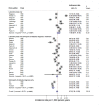Incidence of type 2 diabetes in Japan: a systematic review and meta-analysis
- PMID: 24040326
- PMCID: PMC3765408
- DOI: 10.1371/journal.pone.0074699
Incidence of type 2 diabetes in Japan: a systematic review and meta-analysis
Erratum in
- PLoS One. 2013;8(10). doi:10.1371/annotation/c9e78482-03d2-4cc3-b971-7d91f6ac6cab
- PLoS One. 2013;8(9). doi: 10.1371/annotation/411033ae-4884-42db-826f-b9dda6564860
Abstract
Background: The definition of incident type 2 diabetes varies across studies; hence, the actual incidence of type 2 diabetes in Japan is unclear. Here, we reviewed the various definitions of incident type 2 diabetes used in previous epidemiologic studies and estimated the diabetes incidence rate in Japan.
Methods: We searched for related literature in the MEDLINE, EMBASE, and Ichushi databases through September 2012. Two reviewers selected studies that evaluated incident type 2 diabetes in the Japanese population.
Results: From 1824 relevant articles, we included 33 studies with 386,803 participants. The follow-up period ranged from 2.3 to 14 years and the studies were initiated between 1980 and 2003. The random-effects model indicated that the pooled incidence rate of diabetes was 8.8 (95% confidence interval, 7.4-10.4) per 1000 person-years. We observed a high degree of heterogeneity in the results (I(2) = 99.2%; p < 0.001), with incidence rates ranging from 2.3 to 52.6 per 1000 person-years. Three studies based their definition of incident type 2 diabetes on self-reports only, 10 on laboratory data only, and 20 on self-reports and laboratory data. Compared with studies defining diabetes using laboratory data (n = 30; pooled incidence rate = 9.6; 95% confidence interval = 8.3-11.1), studies based on self-reports alone tended to show a lower incidence rate (n = 3; pooled incidence rate = 4.0; 95% confidence interval = 3.2-5.0; p for interaction < 0.001). However, stratified analyses could not entirely explain the heterogeneity in the results.
Conclusions: Our systematic review and meta-analysis indicated the presence of a high degree of heterogeneity, which suggests that there is a considerable amount of uncertainty regarding the incidence of type 2 diabetes in Japan. They also suggested that laboratory data may be important for the accurate estimation of the incidence of type 2 diabetes.
Conflict of interest statement
Figures



References
-
- Whiting DR, Guariguata L, Weil C, Shaw J (2011) IDF diabetes atlas: global estimates of the prevalence of diabetes for 2011 and 2030. Diabetes Res Clin Pract 94: 311-321. doi:10.1016/j.diabres.2011.10.029. PubMed: 22079683. - DOI - PubMed
-
- Chan JC, Malik V, Jia W, Kadowaki T, Yajnik CS et al. (2009) Diabetes in Asia: epidemiology, risk factors, and pathophysiology. JAMA 301: 2129-2140. doi:10.1001/jama.2009.726. PubMed: 19470990. - DOI - PubMed
-
- Ministry of Health (1997) National Diabetes Survey. Available: http://www.mhlw.go.jp/toukei/kouhyo/indexkk_4_1.html. Accessed 23 August 2012.
-
- Ministry of Health, Labour and Welfare (2002) National Diabetes Survey. Available: http://www.mhlw.go.jp/shingi/2004/03/s0318-15.html#tyosa. Accessed 23 August 2012.
-
- Ministry of Health, Labour and Welfare (2007) National Health and Nutrition Survey. Available: http://www.mhlw.go.jp/bunya/kenkou/eiyou09/01.html. Accessed 23 August 2012.
Publication types
MeSH terms
LinkOut - more resources
Full Text Sources
Other Literature Sources
Medical

